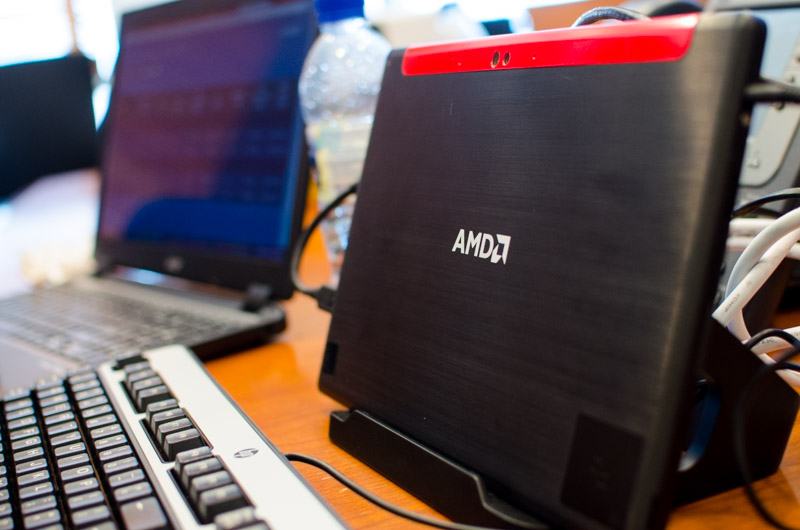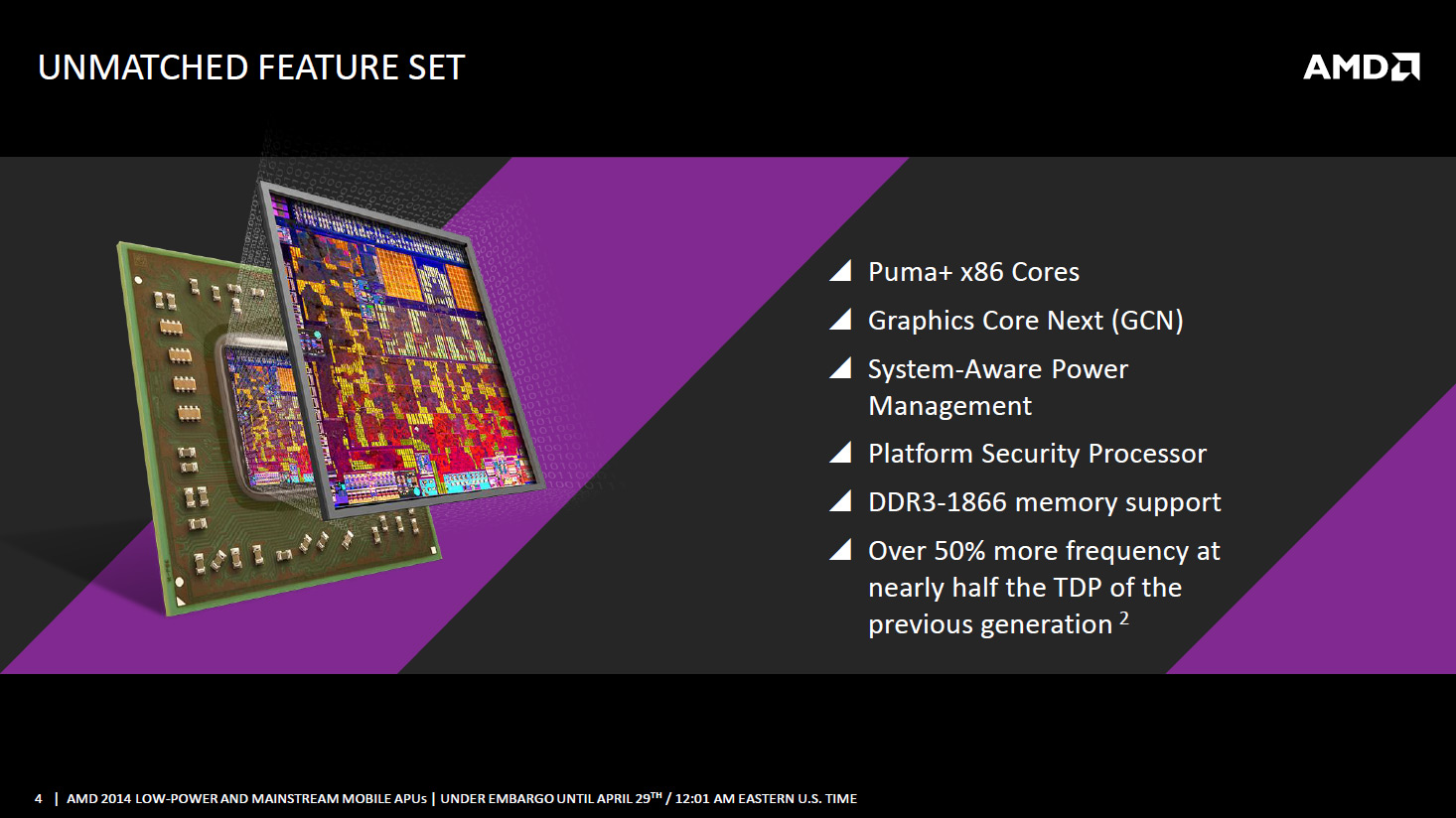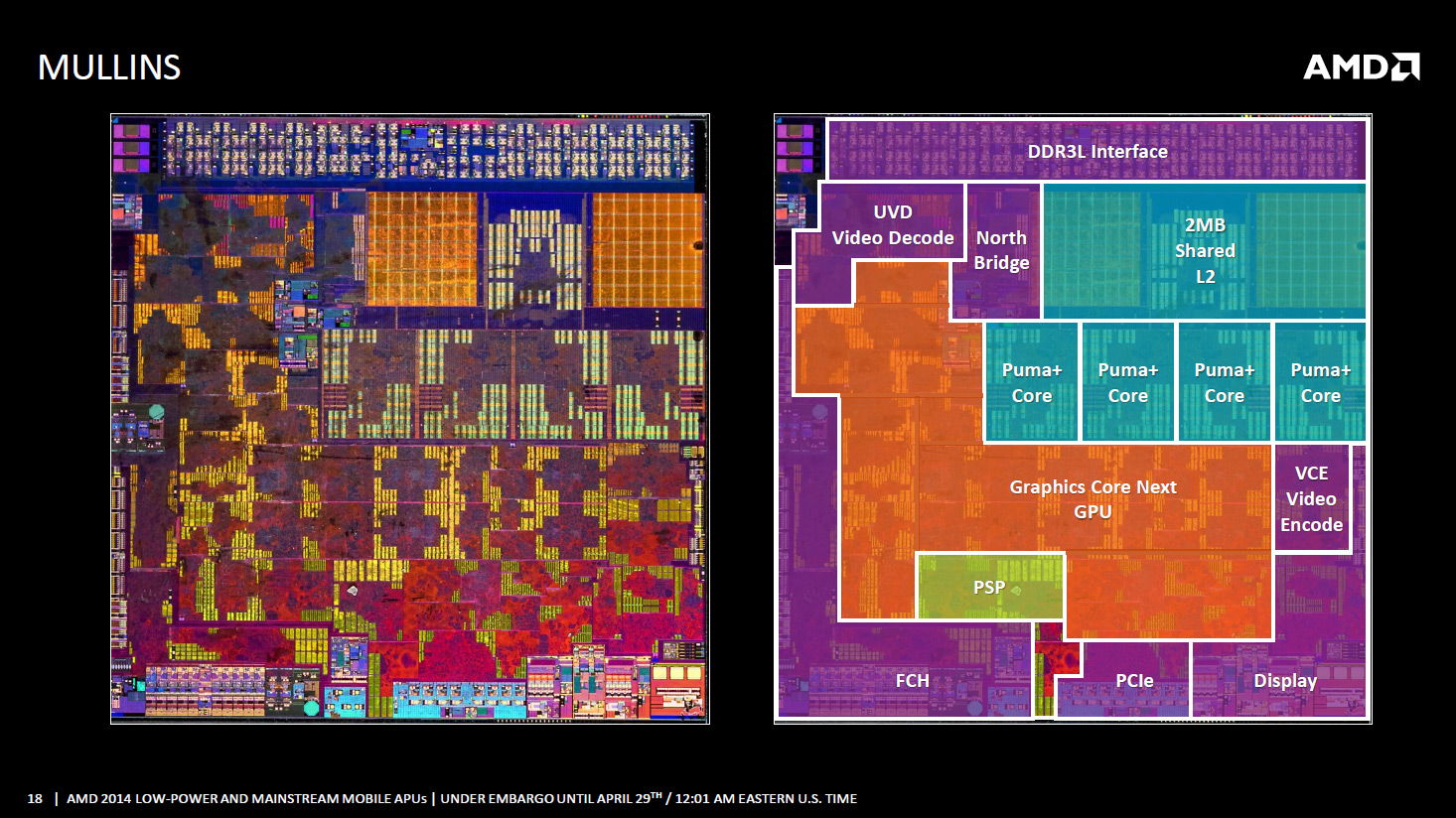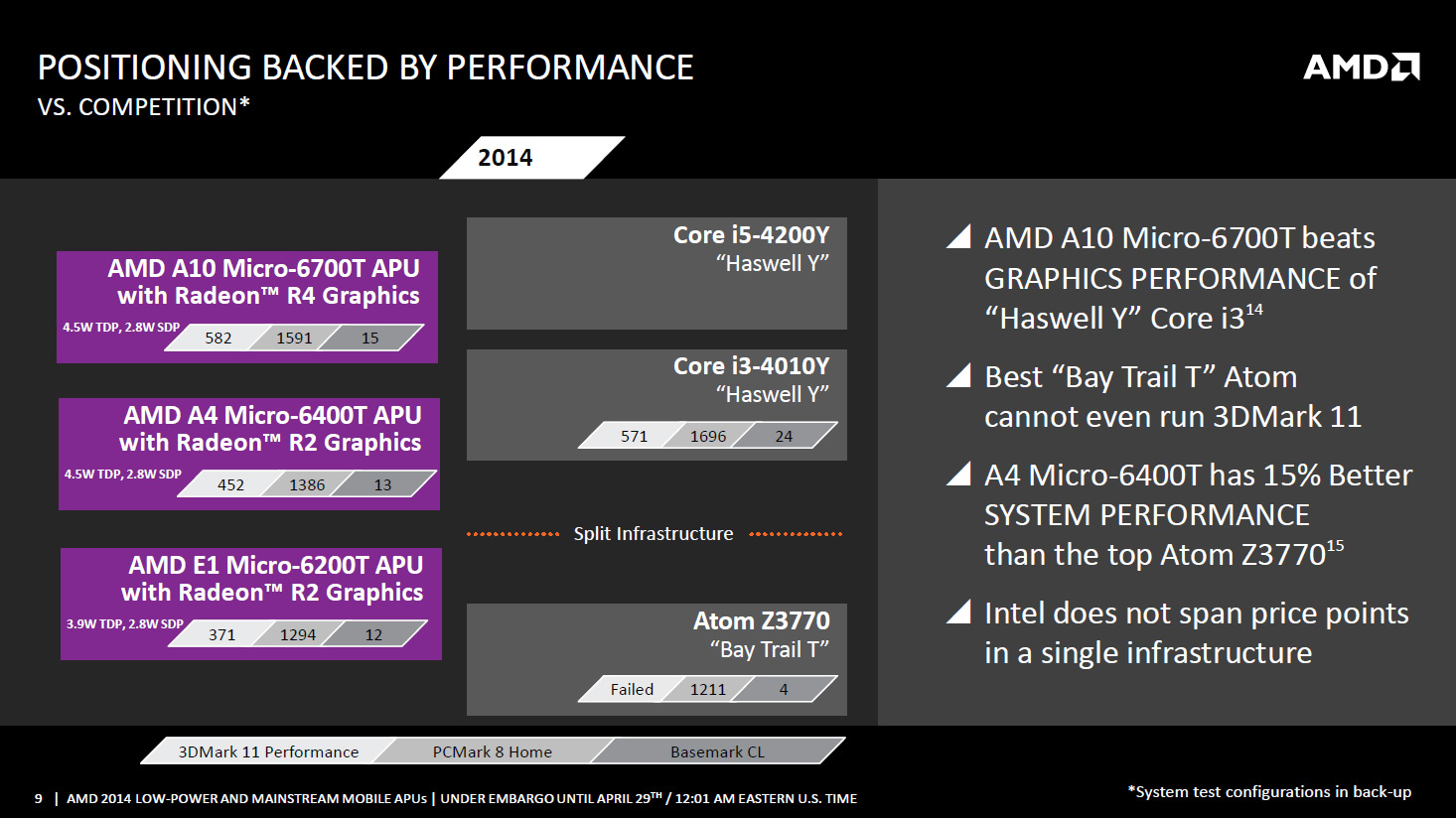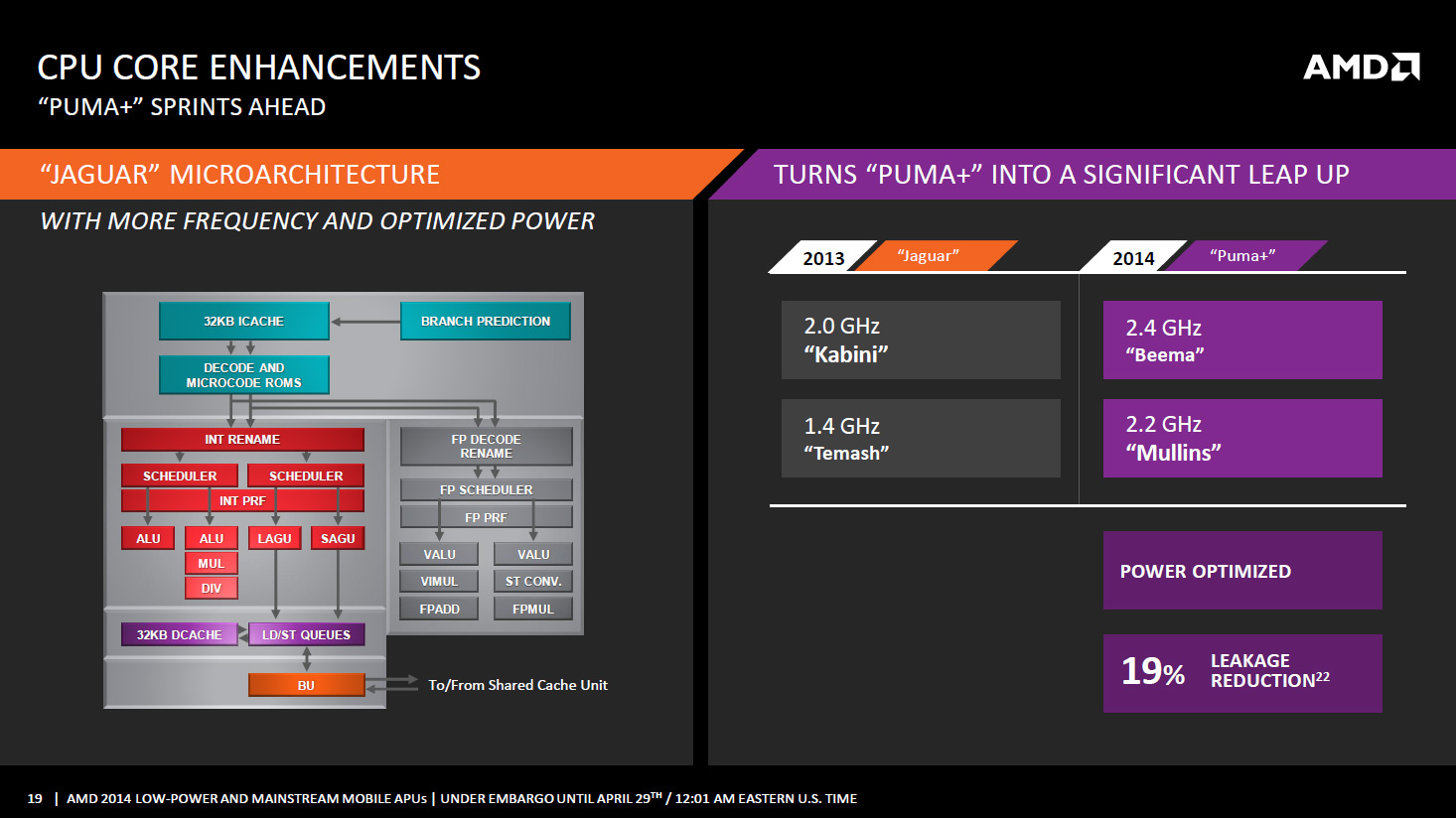Low power computing is an extremely important market for chipset and device manufacturers alike. As we strive to have the best performance in our tablets and notebooks, we also want the longest battery life without having to lug around a chunky, heavy device.
ARM has already established itself as a designer of low-power silicon, and their products and derivatives from manufacturers like Qualcomm are nearly universally found in iOS and Android smartphones and tablets. While five years ago ARM wasn't recognized as a high performing architecture type, they've come a long way with some seriously powerful, low-watt SoCs that we find in tablets like the iPad Air – the A7 is designed by Apple based on ARM's 28-nanometer ARMv8 architecture.
The Windows and x86 story is different. X86 has always been a performance powerhouse, being the instruction set of choice for the world's most powerful systems. In recent years, companies like Intel and AMD have been focused on reducing their x86 chips' power consumption, producing results like Bay Trail and Temash, the former being a highly popular choice for mainstream Windows tablets.
Intel may be a market share leader in this space, but AMD believes that their next generation chips will be the best. A refinement of their work on APUs in the past few years, the new chips - 'Beema' for mainstream laptops, and 'Mullins' for low power tablets - are set to be strong contenders up against Intel's Bay Trail and low-power Haswell offerings.
To take a look at Beema and Mullins, AMD flew me out to their Singapore office to get the lowdown on the products, as well as to give me some hands-on time testing Mullins in their Discovery reference design tablet.
Low Power, High Performance APUs
At the start of 2014, AMD launched their new performance segment APUs, called Kaveri. As Steve has already covered in his reviews of the A8-7600 and A10-7850K, these products feature Steamroller cores, powerful integrated Radeon graphics, and TDPs as high as 95W for their desktop SKUs. Kaveri will also end up in performance laptops at some point, completing the top end of AMD's APU product stack.
Beema and Mullins are quite different to Kaveri, but fill out the bottom end of the stack. Both products make use of AMD's new Puma+ CPU cores, which are the successor to the Jaguar cores found in Kabini (the predecessor to Beema), Temash (the predecessor to Mullins) and the current generation of gaming consoles (the Xbox One and PlayStation 4). Puma+ is a more power efficient CPU architecture, allowing higher clock speeds and greater performance while reducing power consumption.
Like all of AMD's APU offerings, Beema and Mullins also pack a GCN GPU with 128 compute cores and frequencies varying from 300 MHz to 800 MHz. With these new APUs, AMD has again managed to boost clock speeds while reducing power usage; combined with improvements in the CPU and other areas, AMD claims Beema, for example, is 20% more power efficient than Kabini at equivalent tasks.
The power reduction is pretty impressive when you put it in terms of TDPs. The highest-end Mullins part has a TDP of 4.5W, which is significantly less than the 8W TDP of Temash, but manages twice the graphics and productivity performance.
Its competitor from Intel is Bay Trail-T, which has a TDP somewhere in the range of 3-4W (Intel hasn't released specifics), and AMD claims Mullins has a performance advantage across the board. It's harder to say whether power consumption is a win with Intel being vague and a lack of Mullins products in the wild, but I'll be sure to test this down the track.
Interestingly, AMD is confident enough in their product to compare Mullins to Intel's Haswell Y parts, which, going entirely on data provided in their slides, paints an interesting picture. The top-end Mullins product is very slightly faster in graphics than Haswell Y, but falls behind when CPU is factored in. But the biggest thing to note here is Haswell Y has a TDP of no lower than 11.5W, and a "Scenario Design Power" more than 50% higher than Mullins.
AMD also claims the performance of 4.5W Mullins parts this year is at the level of (lower-tier) 25W Kabini parts last year, which is a very impressive statistic if true.
Moving on to Beema, these 15W parts pack equal or greater performance compared to Kabini, but at TDPs 40% lower. Again, going on AMD's figures, Beema categorically smashes 7.5W Bay Trail M chips, especially in the graphics department. Compared to 15W Haswell U parts - the same power consumption as Beema - it's a closer battle, but AMD appears to lead in their favorite areas: graphics and overall compute capabilities.
Unfortunately AMD had no Beema samples available at their Singapore office to test with, so these claims will go unverified until it's available in retail devices. But if AMD is truly getting this sort of performance, Beema will be a very compelling product against a strong Haswell line-up.
Initially, Beema will be available to OEMs in four SKUs, ranging from the quad-core A6-6310 to the dual-core E1-6010. Specifications for these products can be found below.
| Specs | A6-6310 | A4-6210 | E2-6110 | E1-6010 |
| CPU | 4x 2.4 GHz | 4x 1.8 GHz | 4x 1.5 GHz | 4x 1.35 GHz |
| L2 Cache | 2 MB | 2 MB | 2 MB | 1 MB |
| GPU "Cores" | 128 @ 800 MHz | 128 @ 600 MHz | 128 @ 500 MHz | 128 @ 550 MHz |
| Memory |
Single-channel DDR3L-1866 |
Single-channel DDR3L-1600 |
Single-channel DDR3L-1600 |
Single-channel DDR3L-1333 |
| TDP | 15 W | 15 W | 15 W | 10 W |
Mullins will come in three SKUs, the fastest of which is the quad-core A10 Micro-6700T, found in the Discovery tablet I had hands-on time with. Check out the specs for these products below.
| Specs | A10 Micro-6700T | A4 Micro-6400T | E1 Micro-6200T |
| CPU | 4x 2.2 GHz | 4x 1.6 GHz | 2x 1.4 GHz |
| L2 Cache | 2 MB | 2 MB | 1 MB |
| GPU "Cores" | 128 @ 500 MHz | 128 @ 350 MHz | 128 @ 300 MHz |
| Memory |
Single-channel DDR3L-1333 |
Single-channel DDR3L-1333 |
Single-channel DDR3L-1066 |
| SDP / TDP | 2.8 W / 4.5 W | 2.8 W / 4.5 W | 2.8 W / 3.95 W |
Looking at the charts above you'll gather a few other important pieces of information about AMD's low power APUs. Every quad-core SKU features 2 MB of L2 cache, while the dual-core chips have 1 MB. There's a similar story when it comes to memory controllers: high-end Mullins uses single-channel DDR3L-1333, while high-end Beema features single-channel DDR3L-1866 or DDR3L-1600.
Another critical thing to note is that AMD is listing here the max CPU frequencies, which are akin to Intel's Turbo Boost figures. The A10 Micro-6700T will run one core as high as 2.2 GHz, but if all four cores are being utilized we'll see clock speeds top out at 1.5 GHz. You'll find similar differences across the entire product stack.

